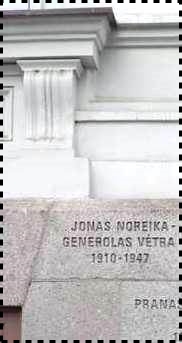From our front page of 29 September 2015:
◊
◊
VILNIUS—The American taxpayer-funded agency known as the “U.S. Commission for the Preservation of America’s Heritage Abroad” has a mission statement that stresses commitment to preserving Jewish cemeteries in post-Holocaust Eastern Europe. They are in special danger because of the Holocaust: the people buried have no descendants or relatives to care for the preservation of their final resting place. Moreover, nationalism and antisemitism sometimes come into play, with powers that be not wanting any city-center reminders of major erstwhile Jewish populations in their cities, and in any case, applying very different standards to the preservation of Jewish and Christian cemeteries. The issue was addressed in a 2014 U.S. Congressional resolution.
SEE MORE ON USPACA’S RECORD ON THE PLANS TO DESECRATE A MAJOR EUROPEAN JEWISH CEMETERY
VILNIUS—For many years it has been a source of deep pain to many Lithuanians, Jews and others that the capital (and cities and towns around the country) continue to have street names honoring Holocaust perpetrators and collaborators but none for the true heroes of the Lithuanian Holocaust — the Lithuanian rescuers, who risked their and their families’ lives to “just do the right thing” and rescue some person or persons of a minority marked for rapid murder on the basis of Jewish birth. In the Baltics, the rescuers had to have much more courage even than in many other countries, because they were regarded as enemies of nationalist patriotism, as then constructed, not only as defiers of the German occupying forces’ program of extermination. They were regarded here as “enemies of Lithuania” (or Latvia, or Estonia), and sympathizes of communism who could expect no mercy if found out either by the German authorities or the local Lithuanian forces.
In 2013, Defending History objected to the plan to name a street for Ona Šimaitė in the boondocks and pressed for her street to be right in the city center.
VILNIUS—Despite the relatively modest number of participants in the hall, around fifty, the 90th Anniversary Conference of Yivo in Vilnius was unanimously judged to be a major success with Yiddish scholars and cultural leaders from Buenos Aires, New York, Tel Aviv and Vilnius reading papers in English, Lithuanian, and Yiddish. Four papers were in Yiddish (by Lea Garfinkel, Dovid Katz, Abraham Lichtenbaum and Mordehay Yushkovsky), representing a serious Yiddish-in-Yiddish component of an academic conference for the first time in years. Yiddish greetings were also delivered by Emanuelis Zingeris, parliamentarian and founder of the city’s Jewish museum. There were greetings from the Israeli ambassador and the Lithuanian parliament and foreign ministry.
INTERNATIONAL OPPOSITION TO “CONVENTION CENTER IN THE JEWISH CEMETERY”
PAPER TRAIL
ISRAEL PAGE
ISRAEL SECTION
7 SOLUTIONS
◊
For many years, international visitors to Rokiškis (in Yiddish: Rákishok, or less formally: Rákeshik), in northeastern Lithuania, have remarked that the town’s central area seemed to preserve little (or no) trace or commemoration of its erstwhile Jewish population, though a large monument now graces the entrance to the old Jewish cemetery outside town. Before the Holocaust, this town was home to around 3,500 Jews (some 40% of the total population, and the overwhelming majority in its central area). Luckily, a short film of pre-Holocaust Jewish Rákishok survives (from 1937), and is available on Youtube. Thanks to Polish film maker Tomek Wisniewski for circulating the link in recent days.
KAUNAS—The Postal Service of Lithuania today launched two handsome commemorative envelopes in memory of two celebrated European consuls in Kaunas who helped thousands of Jews obtain visas that enabled them to leave Lithuania during the final year before the Nazi invasion and the Holocaust came to the country. The two, Chiune Sugihara (1900−1986) of Japan and Jan Zwartendijk (1896−1976) of the Netherlands risked their careers, and more, to disobey instructions and the letter of the law to save those who came to them for help. These were primarily citizens of prewar Poland who found themselves in Lithuania in the summer of 1940, when the country was being absorbed into the USSR, and the consulates and embassies in Kaunas were under pressure to close down altogether.
O B I T U A R I E S / L I T V A K A F F A I R S
◊
The following message following the death of Uri Chanoch (1928-2015) was circulated this week by Julius Berman, president of the Claims Conference in New York.
◊
I am heartbroken to share the news that Uri Chanoch, a dear friend and stalwart supporter of the Claims Conference, and a member of the board of directors and negotiating committee, passed away at his home in Israel on Tuesday night, September 1. I wrote Uri a note earlier this week and told him how much we appreciate and look forward to his exhortations at board meetings as he cried out from the heart about the continuing despicable conduct of certain European nations regarding restitution.
◊
In the midst of this past summer’s heatwave here in Lithuania, Delfi.lt, one of the most popular news portals in the land, exploded with discussions on commemorations and memorials for Nazi collaborators in our country. Rimvydas Valatka, a columnist for the portal and signatory of the Declaration of Independence, started it all with his article of 26 July. The “current events background” was the recent removal of the controversial Soviet-era statues of soldiers on Vilnius’s Green Bridge. Valatka, a veteran of Lithuanian journalism with the rarefied street-cred of a Declaration of Independence signatory, appealed for removal of the memorial plaque for Nazi collaborator Jonas Noreika (“Generolas Vėtra”) from a central Vilnius library building, and wrote about a petition for its removal signed by a group of intellectuals and public figures, and addressed to the mayor of Vilnius as well as to the director of the relevant library (Library of the Lithuanian Academy of Sciences), where the plaque hangs prominently in the heart of Lithuania’s capital.
 The stone honoring Holocaust collaborator Jonas Noreika tops the lot on the facade of the Genocide Museum on Gedimino Boulevard in the Lithuanian capital, a stone’s throw from the nation’s parliament. When are we going to stop glorifying those who helped annihilate Lithuanian Jewry during the Holocaust? When is this going to come down?
The stone honoring Holocaust collaborator Jonas Noreika tops the lot on the facade of the Genocide Museum on Gedimino Boulevard in the Lithuanian capital, a stone’s throw from the nation’s parliament. When are we going to stop glorifying those who helped annihilate Lithuanian Jewry during the Holocaust? When is this going to come down?◊
Having recently spent a few days in Germany, and watching different television channels, I once more realized that that country still broadcasts regular programs on the Holocaust. Nearly each and every evening during my stay, I had the opportunity to see fragments of such programs, broadcast on less popular channels (“ZDF History” for example). And, it is true, it is one of the things that I admire most in modern Germany — the regular televising of documentaries on the Holocaust, never hiding the enormous responsibility of the Nazis in the destruction of the Jews.
◊
 While there has been some research on and recognition of the exiles from Nazism who settled in the UK, little is known about their children: the British second generation, and what the long term effects of their parents’ exile have been on them. Indeed, this has been a largely invisible group. My book Breaking the Silence. Voices of the British Children of Refugees from Nazism (Rowman and Littlefield, 2015) set out to cast light on this second generation group.
While there has been some research on and recognition of the exiles from Nazism who settled in the UK, little is known about their children: the British second generation, and what the long term effects of their parents’ exile have been on them. Indeed, this has been a largely invisible group. My book Breaking the Silence. Voices of the British Children of Refugees from Nazism (Rowman and Littlefield, 2015) set out to cast light on this second generation group.
The following image and text appeared on the website of the Jewish Community of Lithuania earlier today.
NEW YORK—A spokesperson for the rabbinic delegation from the United States, Israel and Europe that came to plea for a reprieve for the old Jewish cemetery in Vilnius issued the following press release upon completion of the group’s meetings. Its content contrasts sharply with the BNS report published in various Lithuanian media today.
◊
VILNIUS—A rabbinic delegation visited Vilnius yesterday and met the authorities to plea with them to cancel plans to construct a congress hall on Šnipiškės Jewish cemetery. The Šnipiškės cemetery was established over five centuries ago, and it interred the most famous Jewish leaders of Vilnius.
WASHINGTON, DC—The chairman of “Admas Kodesh” today posted on a public Facebook page the following item and images, including an obviously posed photo featuring the chairperson of the United States Commission for the Preservation of America’s Heritage Abroad, and Rabbi Andrew Baker of the American Jewish Committee, a close ally of the Lithuanian government and member of its controversial “red-brown commission” that has caused some pain to Holocaust survivors via its support of Baltic “Double Genocide” Holocaust revisionism. “Admas Kodesh” (‘holy earth) is generally used interchangeably for the London-based CPJCE (“Committee for the Preservation of Jewish Cemeteries in Europe”), which is currently involved in a potentially major scandal over alleged payments in return for paid “supervisions” of cemetery desecrations allowed at the old Jewish cemetery in Vilnius. The CPJCE continues to adamantly defend the twenty-five million dollar convention center slated for the middle of the old Jewish cemetery, at a time of virtually unanimous condemnation by rabbis internationally and local people alike. That story was covered in today’s Jerusalem Post.
Mr. Berel Fried of New York City, an Orthodox Jewish scholar and businessman, has authorized this publication of his letter, sent earlier today to Frans Timmermans, first vice president of the European Commission, regarding plans for a convention center at the old Piramónt (Šnipiškės) Jewish cemetery in Vilnius. He is a frequent visitor to Vilnius, where he is known for his exquisite Torah readings at the Choral Synagogue. The most recent public response from the European Commission is here.
LONDON—The “Committee for the Preservation of Jewish Cemeteries in Europe” (CPJCE), affiliated with “Admas Kodesh” and the “Aaronite” splinter group of Satmar hasidism, comprising the rabbis received by the prime minister of Lithuania in Vilnius last April, issued an extraordinary press release today, full of praise for the prime minister (which he no doubt deserves), but without even mentioning the issue at hand: the imminent construction of a twenty-five million dollar convention center in the heart of the cemetery. People attending conventions, concerts, and congresses naturally cheer, clap, drink in bars and use toilets. Here they will do so surrounded by thousands of Jewish graves from over a half millennium of Jewish life in Vilna, once known as the Jerusalem of Lithuania.